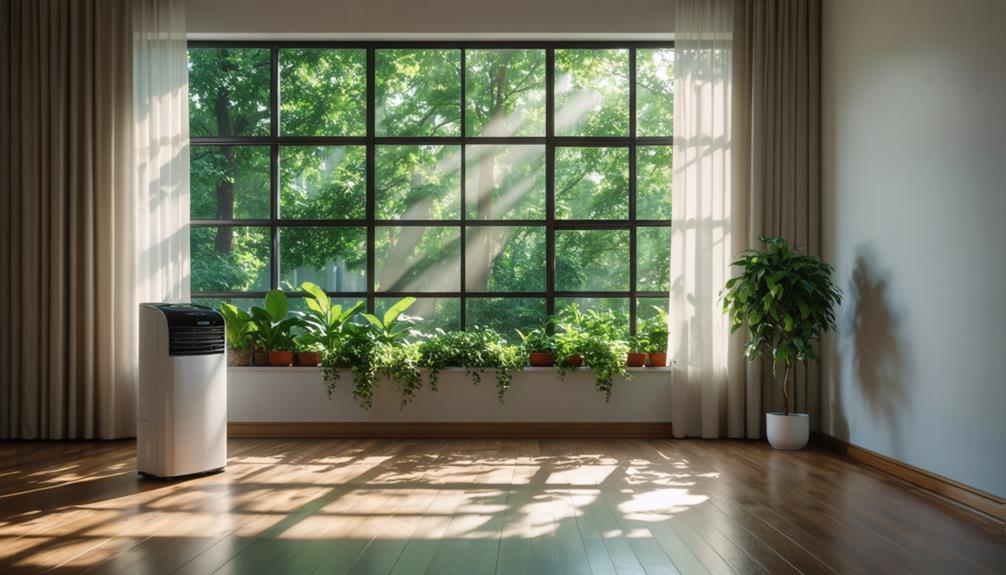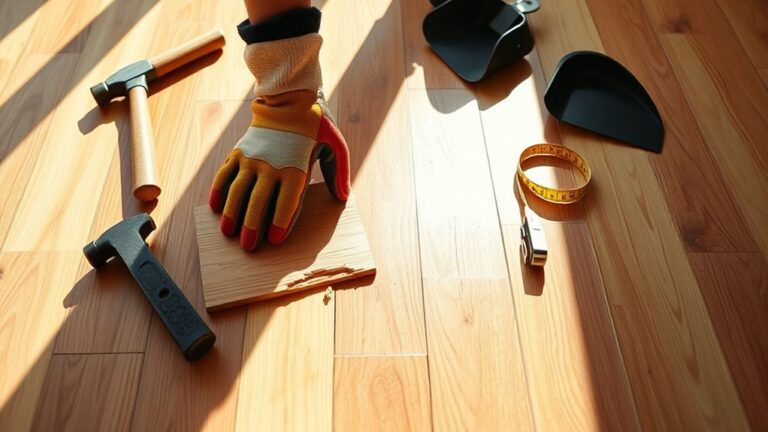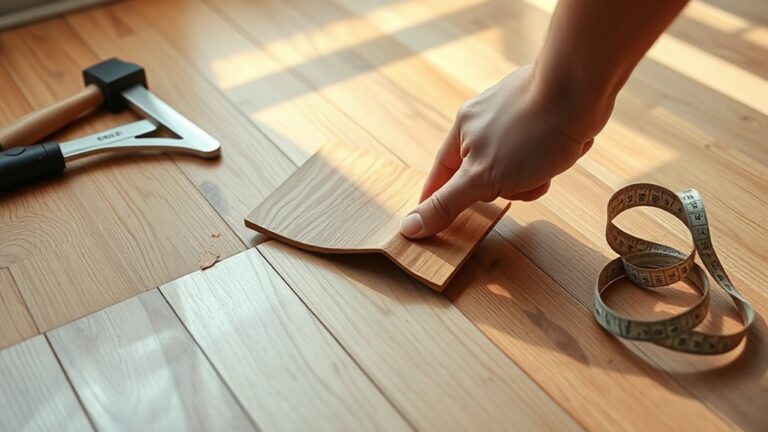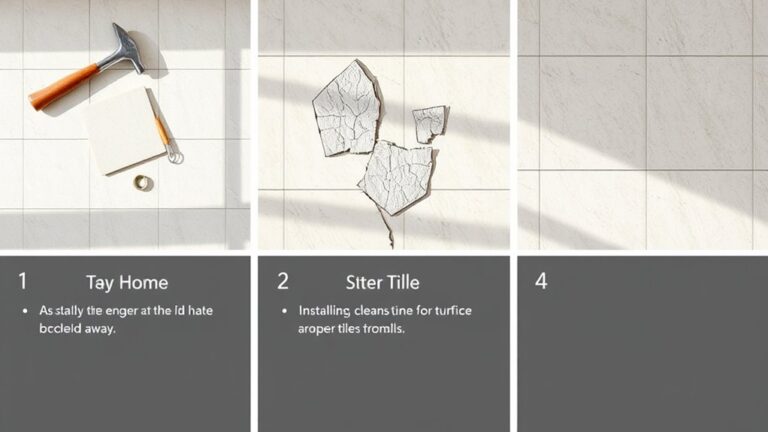When installing hardwood floors in humid areas, you must consider several best practices. First, choose moisture-resistant hardwoods, like engineered varieties of hickory, maple, or oak. Acclimate your flooring for 7-14 days in a controlled environment with temperatures between 60-75°F and humidity at 35-55%. Verify a vapor barrier is installed to protect against moisture intrusion, and prepare the subfloor by verifying it's dry and level. Leave expansion gaps around the perimeter to accommodate natural wood movement. By following these steps, you'll enhance the longevity and performance of your hardwood floors amidst fluctuating humidity conditions, and there's more to explore on maintaining that quality.
Understanding Humidity Effects
When it comes to installing hardwood floors, understanding humidity effects is fundamental for guaranteeing a successful project. High humidity levels, particularly above 55%, can lead to severe issues like cupping and buckling in hardwood flooring. This not only compromises the floor's structural integrity but can also lead to costly repairs. Each hardwood species has a specific equilibrium moisture content (EMC), and any deviations from this can cause the wood to expand or contract, resulting in gaps or warping.
In humid climates, regular moisture measurement is crucial during the installation process. You'll want to ascertain that the wood's moisture content aligns with the indoor environment to prevent complications down the line. Maintaining ideal humidity levels between 30-50% during installation is essential. This range allows the wood to acclimate properly, guaranteeing it performs well and lasts longer.
If you're considering engineered hardwood flooring, it's worth noting that this type of flooring can be more resilient to humidity changes compared to solid hardwood. However, it's still important to monitor moisture levels closely. High summer humidity can also prolong the drying time of finishes applied to hardwood floors, which affects the overall quality of your installation. By being proactive about humidity control and moisture content, you can lay the foundation for a durable and visually appealing floor that stands the test of time.
Choosing the Right Hardwood
Selecting the right hardwood for your flooring project is vital, especially in humid areas where moisture levels can wreak havoc on wood integrity. When choosing the right hardwood, it's important to take into account species that naturally resist humidity. While solid wood might be appealing, engineered hardwood often proves more effective due to its multi-layered construction, providing enhanced stability against moisture fluctuations.
Here's a quick comparison of suitable hardwood species:
| Wood Species | Moisture Resistance Level |
|---|---|
| Hickory | High |
| Maple | Moderate to High |
| Oak | High |
Species like hickory, maple, and oak are ideal for humid climates, offering durability and reduced risk of warping or buckling. Remember to check the equilibrium moisture content (EMC) for each species; deviations can lead to installation issues such as cupping or cracking.
It's also wise to consult with flooring experts who can help identify the best hardwood species for your specific humidity levels and local climate conditions. This guarantees long-lasting performance and aesthetic appeal. By prioritizing moisture-resistant hardwood options, you can safeguard your investment and enjoy a beautiful floor that withstands the challenges posed by humidity and temperature variations.
Benefits of Engineered Hardwood
When considering hardwood flooring, you'll find that engineered hardwood offers enhanced moisture resistance and structural stability, making it an excellent choice for humid environments. Its layered construction minimizes the risk of warping and buckling, while the variety of wood species available allows you to achieve the aesthetic appeal of solid hardwood. Additionally, the flexibility in installation methods guarantees you can meet your specific moisture management needs effectively.
Enhanced Moisture Resistance
One of the standout features of engineered hardwood is its enhanced moisture resistance, making it an excellent choice for areas prone to humidity. Unlike solid hardwood, engineered hardwood has a plywood core that provides superior stability and moisture resistance. This is essential in maintaining the integrity of your floors in fluctuating humidity conditions.
Here are three key benefits of engineered hardwood's moisture-resistant properties:
- Reduced Warping: The multi-layer construction minimizes the risk of warping, cupping, and buckling that often occurs with solid hardwood in humid environments.
- Versatile Installation: You can install engineered hardwood over various subfloors, including concrete, without compromising its performance in moisture-prone areas.
- Durable Species Options: Engineered varieties, like hickory, maple, and oak, are specifically designed to endure high humidity, ensuring long-lasting performance.
With its enhanced moisture resistance, engineered hardwood not only allows for greater design flexibility but also maintains durability in challenging climates. So, if you're looking for a flooring solution that combines aesthetics with practicality, engineered hardwood is a smart choice for humid areas.
Structural Stability Advantages
Engineered hardwood offers significant structural stability advantages that make it a preferred choice for many homeowners. Unlike solid hardwood, engineered hardwood is constructed with multiple layers, including a robust plywood core. This layered design enables it to withstand humidity fluctuations that can wreak havoc on other flooring options.
When you choose engineered hardwood, you minimize the risk of warping, cupping, and buckling. Its construction allows the material to expand and contract evenly in response to changes in moisture levels, which is particularly beneficial in humid environments. This means you won't have to worry about gaps or separation between planks over time, preserving the sleek look of your flooring.
Moreover, the moisture resistance of engineered hardwood translates to lower maintenance and fewer repairs compared to solid hardwood. You can enjoy the aesthetic appeal of wood flooring without the constant upkeep. In environments where humidity levels fluctuate, engineered hardwood stands out as a reliable choice, providing long-lasting performance and structural stability that keeps your home looking its best. Embracing engineered hardwood not only enhances the durability of your floors but also gives you peace of mind in varying climates.
Aesthetic Versatility Options
Aesthetic versatility is a hallmark of engineered hardwood, making it an ideal choice for homeowners seeking to complement their individual design preferences. This flooring option excels in humid climates, providing stability while offering a range of aesthetic possibilities. Here are three key benefits that highlight its versatility:
- Diverse Styles: Engineered hardwood comes in a wide array of colors, finishes, and textures, accommodating everything from traditional to contemporary designs. You can effortlessly match your flooring to your unique decor.
- Creative Patterns: The layered construction allows for intricate designs and patterns, giving you more options than solid hardwood. You can create visually striking layouts that enhance the overall appearance of your space.
- Exotic Looks at a Lower Cost: Modern manufacturing techniques enable engineered hardwood to mimic the look of exotic woods. This means you can achieve a luxurious aesthetic without the hefty price tag or maintenance issues associated with solid wood.
In humid climates, the stability of engineered hardwood guarantees that its aesthetic appeal remains intact, free from warping or buckling, making it a reliable choice for your beautiful home.
Acclimation Process Essentials
To guarantee a successful hardwood floor installation, you'll need to follow specific acclimation duration guidelines, which typically range from 7 to 14 days. During this time, maintaining ideal environmental conditions—specifically a temperature between 60-75°F and humidity levels of 35-55%—is essential. Proper acclimation prevents future issues like warping or gaps, safeguarding your investment.
Acclimation Duration Guidelines
Acclimating hardwood flooring is a critical step that shouldn't be overlooked, as it helps assure the wood adapts to your home's specific climate conditions. The recommended acclimation period for hardwood flooring is typically between 7 to 14 days. Here are some essential guidelines to keep in mind during this process:
- Monitor Indoor Humidity Levels: Maintain relative humidity between 35-55%. Use a humidistat for continuous tracking.
- Temperature Control: Ensure indoor temperatures stay between 60-75°F. This range promotes proper moisture content in the wood.
- Storage Conditions: Store the flooring in the environment where it will be installed, shielded from outdoor elements.
Failing to adhere to these acclimation guidelines can lead to issues like cupping, buckling, or gaps in the flooring post-installation. A moisture meter can help you confirm that the wood has reached the ideal moisture content before you proceed. Remember, taking the time to acclimate your hardwood flooring properly can save you from costly repairs later and enhance the longevity of your beautiful new floors.
Ideal Environmental Conditions
Proper acclimation of hardwood flooring sets the stage for successful installation, and understanding the ideal environmental conditions is key to this process. For optimal results, aim for a relative humidity (RH) of around 45%, maintaining levels between 30-50%. This balance is essential to prevent the wood from expanding or contracting post-installation.
During the acclimation phase, which should last 7-14 days, keep the temperature between 60-75°F. This helps align the wood's moisture content with your indoor environment. Continuous monitoring of humidity levels is indispensable; using a humidistat will allow you to catch any deviations early, preventing potential installation issues.
Store your flooring indoors, away from outdoor elements, to minimize exposure to fluctuating humidity. Additionally, running heating or air conditioning for at least five days prior to installation will stabilize indoor conditions, creating the best environment for your hardwood.
Ideal Installation Conditions
When it comes to installing hardwood floors, achieving the right installation conditions is critical for ensuring a successful outcome. Proper management of humidity levels and temperature can prevent future complications, ensuring your flooring looks great for years to come. Here are three key factors to take into account:
- Humidity Levels: The ideal relative humidity (RH) for hardwood installation is around 45%. If levels drop below 40%, you'll need to add moisture, while levels above 60% require dehumidification. Keeping track of these readings with a humidistat will help prevent issues related to excess moisture or dryness.
- Temperature: During installation, maintain a temperature between 60-80°F. This range allows the wood to acclimate properly to the environment, minimizing the risk of warping or shrinking post-installation.
- Acclimation Period: Store your hardwood flooring indoors for at least 7-14 days before installation. This acclimation period enables the wood to adjust to your home's humidity and temperature, reducing the likelihood of expansion or contraction once installed.
Additionally, remember to leave expansion gaps around the perimeter of the flooring. These gaps are essential to accommodate the natural movement of wood caused by humidity fluctuations. By adhering to these ideal installation conditions, you'll set your hardwood floors up for long-lasting beauty and performance.
Moisture Measurement Techniques
Monitoring moisture levels is a critical part of the hardwood installation process, especially after establishing ideal installation conditions. To ascertain your hardwood flooring is suitable for installation, you'll want to measure the moisture content upon its arrival at the jobsite. This initial assessment sets a baseline for your project.
During the acclimation process, it's important to check moisture levels regularly. This helps confirm that the wood is aligning with the indoor environment's humidity and temperature. Specialized meters, like the Wagner Rapid RH, are essential for accurately measuring moisture in concrete subfloors before you proceed. These devices guarantee that the subfloor isn't too damp, which can lead to significant issues later on.
After installation, take final moisture measurements to verify that the flooring has reached the appropriate moisture content. This step is critical for peak performance and longevity, as excessive moisture can lead to warping and other complications. Additionally, during the finishing process, monitoring moisture content between coats is necessary. This ensures that the wood is adequately prepared, avoiding issues with adhesion and drying times.
Indoor Humidity Control Strategies
Controlling indoor humidity is essential for maintaining the integrity of your hardwood floors. By keeping humidity levels between 35%-55%, you can protect your floors from the damaging effects of moisture fluctuations, such as expansion and contraction. Here are some effective strategies to help you control indoor humidity:
- Use Dehumidifiers: Invest in a good quality dehumidifier, especially during high humidity seasons. This device can considerably reduce excess moisture in the air, preventing issues like cupping and buckling of your hardwood floors.
- Monitor with a Hygrometer: Regularly check humidity levels using a hygrometer. This simple gadget allows you to stay informed about indoor conditions, enabling you to make necessary adjustments to maintain ideal humidity.
- Run Air Conditioning: During hot, humid months, running your air conditioning not only cools your living space but also helps stabilize humidity levels. This dual functionality supports the integrity of your flooring.
Additionally, promptly cleaning spills and placing area rugs in moisture-prone areas can mitigate the risk of water damage. By implementing these humidity control strategies, you can guarantee your hardwood floors remain beautiful and long-lasting. Remember, maintaining the right moisture balance not only enhances your floor's performance but also contributes to a more comfortable living environment.
Maintenance Practices for Longevity
To guarantee your hardwood floors stand the test of time, implementing a consistent maintenance routine is essential. One of the most significant aspects is monitoring indoor humidity levels. Aim to keep them between 35%-55% to prevent moisture from the air, which can lead to warping and cupping.
Additionally, it's important to address spills immediately. Any moisture exposure can compromise your flooring's integrity, so be quick to clean up and minimize potential damage. When cleaning, use a damp mop rather than soaking the wood, and choose hardwood-specific cleaners to maintain the finish without causing harm.
Regular inspections are also important. Look for signs of moisture damage, such as cupping or buckling, and tackle any issues promptly. This proactive approach can prevent minor problems from escalating into costly repairs. Finally, schedule regular resealing of your hardwood floors to create a barrier against moisture and to maintain their aesthetic appeal and durability.
Here's a quick reference table for your maintenance routine:
| Task | Frequency |
|---|---|
| Monitor humidity levels | Weekly |
| Clean spills | As they occur |
| Damp mop cleaning | Bi-weekly |
| Inspect for damage | Monthly |
| Reseal floors | Annually |
Recommended Flooring Types
When selecting the right flooring type for your home, engineered hardwood stands out as a top choice, especially in areas prone to humidity. Its multi-layer construction enhances stability and moisture resistance, making it an ideal option compared to solid hardwood. Here are three recommended types of engineered hardwood that excel in humid environments:
- Engineered Hickory: Known as the hardest domestic hardwood, engineered hickory is perfect for high-traffic areas. Its exceptional durability guarantees it maintains structural integrity even when humidity levels fluctuate.
- Engineered Maple: This type features a fine grain and ranks as the second hardest hardwood. Engineered maple not only adds aesthetic appeal to your space but also provides resilience against moisture, making it a great choice for humid areas.
- Engineered Oak: As the third hardest hardwood, engineered oak is a strong and stable option. It's less prone to warping, which is vital in environments with high humidity levels. Its durability of hardwood flooring guarantees long-lasting performance, making it another excellent selection.
Each of these engineered hardwood types offers unique benefits, combining beauty and practicality. By choosing the right flooring, you can enjoy the freedom of living in your home without worrying about the adverse effects of humidity on your floors. Make sure you consider these options for a stylish and resilient flooring solution!
Frequently Asked Questions
What Humidity Is Too High for Hardwood Floors?
Humidity above 55% is too high for hardwood floors, as it can lead to moisture effects like cupping and buckling. To mitigate these risks, install moisture barriers and allow for an acclimation period, ensuring the wood adjusts to your home's humidity levels. Ideally, maintain indoor humidity between 30-50%. Regularly monitor humidity with hygrometers to prevent exceeding these thresholds, safeguarding your flooring's longevity and performance while enjoying your space freely.
What Should the Humidity Level Be to Install Hardwood Floors?
To install hardwood floors, you'll want the humidity level to be around 45%. This helps your flooring types avoid expansion or contraction issues. During the acclimation period, maintaining stable humidity between 35-55% is essential. If humidity's too low, consider adding moisture barriers, while levels above 60% may require dehumidification to prevent buckling. Monitoring these levels consistently guarantees your installation remains effective and your floors stay beautiful for years to come.
When Should You Not Install Hardwood Floors?
You shouldn't install hardwood floors when humidity levels are consistently above 60% or below 30%, as both conditions present significant installation challenges. Excess moisture can lead to warping, while dry air causes gaps. If the subfloor's moisture content exceeds manufacturer specifications, it's also a no-go. Consider flooring alternatives like laminate or vinyl, which handle moisture better. Additionally, using moisture barriers can help protect your investment in less-than-ideal conditions.
What Should the Humidity Be Under a Wooden Floor?
They say, "An ounce of prevention is worth a pound of cure." For your wooden floor, humidity should ideally stay between 35%-55%. This range helps prevent issues like cupping and buckling. It's crucial to use a moisture barrier during installation and follow the acclimation process for the wood. Regular flooring maintenance, including checking humidity with a hygrometer, will keep your floors in top shape and prolong their lifespan.




